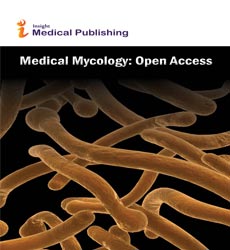Abstract
Prevalence and risk factors for the occurrence of vaginal candidiasis in women of childbearing age at the university Hospital Center of Brazzaville
Introduction: Vaginal candidiasis is a mycosis caused by a yeast of the genus Candida. It affects more than 75% of women during periods of genital activity. Changes in vaginal pH due to a variety of factors contribute to the onset of the disease.
Objective: To determine the prevalence and risk factors associated with the occurrence of vaginal candidiasis in women received at the parasitology-mycology laboratory of the Centre Hospitalier Universitaire de Brazzaville (CHUB) for vaginal swab analysis.
Materials and methods: A descriptive and analytical crosssectional study was conducted from July to October 2019. It involved all patients received at the CHUB parasitologymycology and parasitic immunology laboratory for vaginal swab analysis. Socio-demographic, clinical and biological data were collected using a specially designed questionnaire. For each vaginal swab, direct examination and culture on Sabouraud chloramphenicol medium with and without actidione* were performed. Statistical analysis was performed by SPSS 20 using the chi square test and student's t test and multivariate logistic regression was performed. The test was significant when p˂0.05.
Results: A total of 152 women were included in the study. The median age of patients was 32 years (24, 40). Direct examination was positive in 88 samples (48.7%). Culture results were positive in 34 patients, representing a prevalence of 22.4% of vaginal candidiasis. The majority of patients had only one sexual partner (79.4%), with no history of abortion (64.7%). They had taken antibiotics (2.9%), corticosteroids (5.9%) and diabetes (6.6%). 32.4% were pregnant. Intimate bathing was practiced by 38.2% of patients. 14.7% used community towels; 23.5% wore synthetic undergarments; 26.5% wore tight-fitting clothes and 26.4% had poor post-defecation cleansing habits (p=0.003). Symptoms associated with vaginal candidiasis were significantly leucorrhoea (38.2%; p=0.000), burning sensation (22.4%; p=0.003) and vulvar pruritus (35.5%; p=0.016). The risk factors associated with the occurrence of vaginal candidiasis were the presence of leucorrhoea and the coupled front-to-back/back-to-front mode of cleaning after defecation. Patients with leucorrhoea had a 4.21-fold increased risk of vaginal candidiasis, while those with a coupled front-to-back/back-to-front cleaning mode had a 28.97-fold increased risk.
Conclusion: The results of our study showed the frequency of vaginal candidiasis among women seen at Brazzaville university hospital. The risk factors associated with the occurrence of vaginal candidiasis were the presence of leucorrhoea and the coupled front-to-back/back-to-front cleaning method.
Author(s): Sekangue Obili G, Potokoue Mpia NSB, Ossibi Ibara BR, Itoua C, Djendja Ingoba I, Gackosso G, Buambo G, Iloki LH
Abstract | Full-Text | PDF
Share this

Google scholar citation report
Citations : 164
Medical Mycology: Open Access received 164 citations as per google scholar report
Abstracted/Indexed in
- Google Scholar
- China National Knowledge Infrastructure (CNKI)
- Directory of Research Journal Indexing (DRJI)
- WorldCat
- Publons
- Geneva Foundation for Medical Education and Research
- Secret Search Engine Labs
Open Access Journals
- Aquaculture & Veterinary Science
- Chemistry & Chemical Sciences
- Clinical Sciences
- Engineering
- General Science
- Genetics & Molecular Biology
- Health Care & Nursing
- Immunology & Microbiology
- Materials Science
- Mathematics & Physics
- Medical Sciences
- Neurology & Psychiatry
- Oncology & Cancer Science
- Pharmaceutical Sciences
